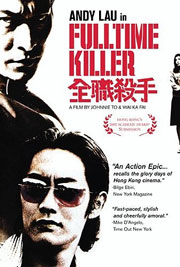Missing Reels: “Fulltime Killer” (2001)
Missing Reels examines overlooked, unappreciated or unfairly maligned movies. Sometimes these films haven’t been seen by anyone, and sometimes they’ve been seen by everyone… who loathed them. Sometimes they’ve simply been forgotten. But in any case, Missing Reels argues that they deserve to be seen and admired by more people.

Hong Kong has long been the source of lots of great action, from the Shaw Brothers’ kung fu epics, to John Woo’s ultra-cool crime stories of the ’80s and ’90s. But while many people may think that the action scene has moved on to other parts (mostly Thailand and South Korea, plus a mini-boom of excellent American direct-to-video films like “Universal Soldier: Day of Reckoning” and its ilk), there’s still a lot to offer from the once reigning king of cinematic punches and gunshots. Johnnie To is most famous for his “Election” films, gripping crime dramas about rival gangs and who controls them, but before he made those, he directed a film (with Wai Ka-Fai) that oozes charm, a clever narrative structure and excellent action sequences.
2001’s “Fulltime Killer” is the story of two rival assassins: O (Takashi Sorimachi) is a methodical and utilitarian killer for hire who dispatches his targets with a cold, emotionless disconnect; Lok (Andy Lau) is a flamboyant slayer of men who is inspired by western action flicks and makes each kill an operatic masterpiece of mayhem. O is the top assassin in Asia, given the big paying jobs because he always gets them done and remains steps ahead of Interpol. Lok is sick of living in O’s shadow and decides to target the top dog by first integrating himself into O’s life, then by taking out O’s targets himself, before eventually directly confronting the killer. It’s a blend of the cool of John Woo’s “The Killer,” the tense buddy relationship at the heart of “Hard Boiled,” mixed with the self-reflective skin of a Tarantino bloodbath.
“Fulltime Killer” is a fun movie with lots of great action sequences and movie references, but it’s the characterization that drives the story and the enjoyment of the audience. Sorimachi plays O like the lone wolf of “Le Samourai” or “Leon” (which is name-checked in the film), who has safeguards in place to ensure that he is nothing more than a ghost in society and that nothing can be traced back to him. He’s a sad man who seemingly has no real life outside of his deadly career, a living funeral dirge that walks silently amongst the world without making any real connections. Lok, on the other hand, is careless and embraces his insane life, willing to tell anyone who’ll listen that he’s a professional killer. He dates O’s cleaning lady, Chin (Kelly Lin), as a way of getting closer to his rival but also because he needs that human connection; he needs to be seen and noticed.
What’s more, the action isn’t simply a cool exercise in explosions and gunfights but an extension of the characters themselves. Take the first time that Lok presents himself to O, snaking out his intended targets while wearing a Bill Clinton mask (a la “Point Break”) and the symphonic music soars in his theatrical assassination, while O merely watches on from his protective perch above the fray.
That needle at the end is full of distilled, pure nicotine that gives Lok a great little one-liner but also is a pretty inventive way of killing someone. The action is great and incredibly well-staged, but it also immediately lets the audience know the differences between Lok and O. It’s not action for action’s sake (though there’s nothing wrong with that), but it is an extension of these two characters; the way they operate is the way they live their lives. Both are seemingly effective, but which one should the audience root for: cold and safe or flamboyant and ultimately self-destructive?
As the movie progresses, the narrative begins to shift in multiple ways. First, the game of cat and mouse that O and Lok are playing becomes much more of a mutual admiration society. They know they can’t both exist in this world, competing ethos and all, but they seemingly appear to embrace the other half of their coin and become much friendlier rivals. Secondly, as the story goes on it becomes evident that each is rubbing off on the other, as evidenced by this scene where the reserved O suddenly takes on some rather bold moves when evading Interpol:
The whole “we’re not so different, you and I” tack plays not as corny cliché but instead as a sincere act of character growth born from the events in which O now finds himself.
“Fulltime Killer” is overshadowed both by To’s later “Election” films and Lau’s “Infernal Affairs” (remade as “The Departed” in the U.S.), but it is an excellent entry in the action genre. It has a lot of great, and surprising, sequences that riff on previous films while being unique in their own right. But it’s really the character work and the entertainment factor of seeing these two extremes go at it that brings me back to the film over and over again. That sense that no one else could possibly understand them but each other, and yet they must destroy each other to live. The constant film references by the flashy Lok, or the isolated agoraphobic activities of O, all paint a clear picture of who these people are and why we’re so invested in the story. Usually when you hear “action film,” you’re not prepared to actually care about any characters – they’re all just fodder for an explosion or two. With “Fulltime Killer,” not only do you care, but you can’t wait to see what they do next.
Related Posts
Comments Off on Missing Reels: “Fulltime Killer” (2001)
Posted in: Entertainment, Movies
Tags: Fulltime Killer, Johnnie To, Missing Reels, Staff Picks - Movies








